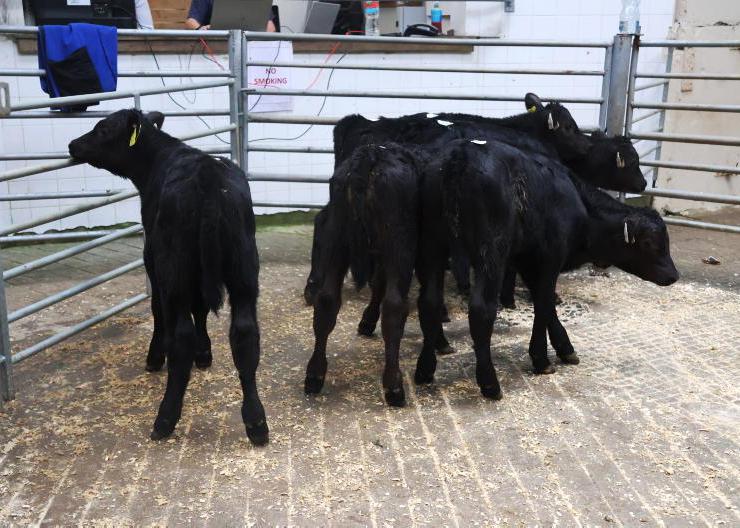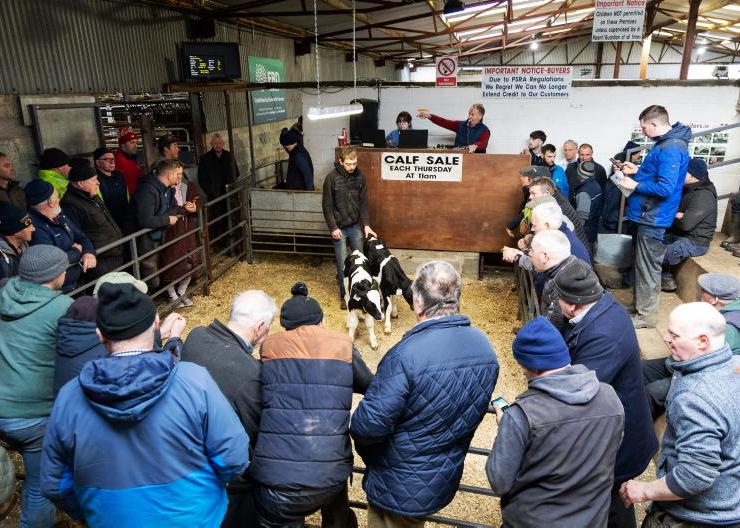Over the last six weeks, more than 150 calves arrived on to the Thrive demonstration farm outside Cashel, Co Tipperary.
Most arrived during the last week of February and the first three weeks of March, despite buying being stopped for a period in early March due to high prices.
This year, most calves are sired by either Angus or Hereford, with just a handful of continental calves purchased later in spring. The reason for this simply comes back to price.
Calf prices this spring have been consistently running €30 to €40 ahead of last year, in most cases. Dairy-beef systems operate on tight margins.

Calves then move on to larger pens of around 30 to 35.
We were not willing to purchase calves just for the sake of having them on-farm again this year. The demonstration farm needs to be run as a commercial enterprise that must stand on its own two feet financially.
Calf prices
In late February, we paid €220 for early maturing heifers and as much as €240 for bulls at between two and three weeks old. Continental calves were trading at such high prices that they weren’t even considered at this point in spring.
While the prices paid in February were above what we had budgeted for, it was expected that calf price would correct itself in early March and the average price paid would even itself out over the entire season.
With the farm operating a 19- to 20-month finishing system, we need to be working with a February or first half of March-born calf
However, prices in early March actually strengthened slightly. So much so that purchasing for the programme halted for a week or 10 days until there was some downward movement on price.
With the farm operating a 19- to 20-month finishing system, we need to be working with a February or first half of March-born calf.
Later-born calves struggle to have sufficient weight to be slaughtered off grass at the end of the second grazing season.
This left us in a difficult situation, where we were trying to strike the balance between a workable calf price and a suitable calf birthdate.
Once buying recommenced, early maturing heifers were being bought for around €180, while bulls were coming in at a cost of €200.
This saw our average price paid settle at €185 for Angus and Hereford heifers and €218 for bulls of the same breeds.
Alongside this, we have a handful of Aubrac (average price €190), Simmental (€235) and Belgian Blue (€300) calves making up the reminder of this year’s batch.
In some ways, this is quite reflective of what is out there in terms of beef-sired dairy calves. The majority is made up of Angus and Hereford, with other breeds a long way behind in terms of numbers.
Calf rearing
Farmer John Hally was happy to report that calves are doing well on-farm this spring. However, when dealing with this number of calves, there are always going to be a few issues.

Prior to weaning, calves need to be eating at least 1kg/day concentrate.
Bloat was the biggest problem this spring, with a number of cases particularly in the first batches of calves that arrived on-farm. This typically happened within the first week of arrival, as calves transitioned to their new diet.
When it was an issue, John increased the feed from 2.5l/head to 3l/head by increasing the amount of water while keeping the milk replacer concentration at the same level.
This seemed to work and over the course of a few days, John pulled back the water proportion again without any further issues.
Pneumonia
Two weeks ago, John noticed a few calves off form and slow or reluctant to drink when feeding. On closer inspection, they were found to have a high temperature.
This was during a period of cold weather, with high winds coming from the north and northeast.
Early intervention meant that sick calves made a full recovery. John was quick to point out that the calves were vaccinated against pneumonia and as a result were easier to cure.
However, had he not been as quick to spot the sickness, it might have been a different story – consistent attention to detail and early intervention when it comes to sickness in calves will keep mortality at a minimum.
Calves out by day
At this stage, the oldest calves are almost eight weeks old and have been transitioned on to once-a-day feeding.
There are a number of paddocks close to the yard that these oldest two batches of 30 calves now have access to during the day.
There is good shelter around the paddocks and calves can go back into the shed at any time during the day if they wish to do so.
The older calves are really starting to increase concentrate intake and will be eating well in excess of 1kg at the point of weaning
This is a great way to transition calves to grass. Once the weather is milder, these two batches will go to grass full-time and the next oldest batches of calves will move to these paddocks around the yard.
Weaning will begin in about a fortnight. The older calves are really starting to increase concentrate intake and will be eating well in excess of 1kg at the point of weaning.
Grazing targets
We will target low grass covers for calves for the first half of the grazing season, typically aiming for sward heights of around 8cm.
Calves will be moved every two to three days in order to keep grass fresh and the yearlings will be used to follow the calves to clean out some paddocks, should they be needed.
Over the last six weeks, more than 150 calves arrived on to the Thrive demonstration farm outside Cashel, Co Tipperary.
Most arrived during the last week of February and the first three weeks of March, despite buying being stopped for a period in early March due to high prices.
This year, most calves are sired by either Angus or Hereford, with just a handful of continental calves purchased later in spring. The reason for this simply comes back to price.
Calf prices this spring have been consistently running €30 to €40 ahead of last year, in most cases. Dairy-beef systems operate on tight margins.

Calves then move on to larger pens of around 30 to 35.
We were not willing to purchase calves just for the sake of having them on-farm again this year. The demonstration farm needs to be run as a commercial enterprise that must stand on its own two feet financially.
Calf prices
In late February, we paid €220 for early maturing heifers and as much as €240 for bulls at between two and three weeks old. Continental calves were trading at such high prices that they weren’t even considered at this point in spring.
While the prices paid in February were above what we had budgeted for, it was expected that calf price would correct itself in early March and the average price paid would even itself out over the entire season.
With the farm operating a 19- to 20-month finishing system, we need to be working with a February or first half of March-born calf
However, prices in early March actually strengthened slightly. So much so that purchasing for the programme halted for a week or 10 days until there was some downward movement on price.
With the farm operating a 19- to 20-month finishing system, we need to be working with a February or first half of March-born calf.
Later-born calves struggle to have sufficient weight to be slaughtered off grass at the end of the second grazing season.
This left us in a difficult situation, where we were trying to strike the balance between a workable calf price and a suitable calf birthdate.
Once buying recommenced, early maturing heifers were being bought for around €180, while bulls were coming in at a cost of €200.
This saw our average price paid settle at €185 for Angus and Hereford heifers and €218 for bulls of the same breeds.
Alongside this, we have a handful of Aubrac (average price €190), Simmental (€235) and Belgian Blue (€300) calves making up the reminder of this year’s batch.
In some ways, this is quite reflective of what is out there in terms of beef-sired dairy calves. The majority is made up of Angus and Hereford, with other breeds a long way behind in terms of numbers.
Calf rearing
Farmer John Hally was happy to report that calves are doing well on-farm this spring. However, when dealing with this number of calves, there are always going to be a few issues.

Prior to weaning, calves need to be eating at least 1kg/day concentrate.
Bloat was the biggest problem this spring, with a number of cases particularly in the first batches of calves that arrived on-farm. This typically happened within the first week of arrival, as calves transitioned to their new diet.
When it was an issue, John increased the feed from 2.5l/head to 3l/head by increasing the amount of water while keeping the milk replacer concentration at the same level.
This seemed to work and over the course of a few days, John pulled back the water proportion again without any further issues.
Pneumonia
Two weeks ago, John noticed a few calves off form and slow or reluctant to drink when feeding. On closer inspection, they were found to have a high temperature.
This was during a period of cold weather, with high winds coming from the north and northeast.
Early intervention meant that sick calves made a full recovery. John was quick to point out that the calves were vaccinated against pneumonia and as a result were easier to cure.
However, had he not been as quick to spot the sickness, it might have been a different story – consistent attention to detail and early intervention when it comes to sickness in calves will keep mortality at a minimum.
Calves out by day
At this stage, the oldest calves are almost eight weeks old and have been transitioned on to once-a-day feeding.
There are a number of paddocks close to the yard that these oldest two batches of 30 calves now have access to during the day.
There is good shelter around the paddocks and calves can go back into the shed at any time during the day if they wish to do so.
The older calves are really starting to increase concentrate intake and will be eating well in excess of 1kg at the point of weaning
This is a great way to transition calves to grass. Once the weather is milder, these two batches will go to grass full-time and the next oldest batches of calves will move to these paddocks around the yard.
Weaning will begin in about a fortnight. The older calves are really starting to increase concentrate intake and will be eating well in excess of 1kg at the point of weaning.
Grazing targets
We will target low grass covers for calves for the first half of the grazing season, typically aiming for sward heights of around 8cm.
Calves will be moved every two to three days in order to keep grass fresh and the yearlings will be used to follow the calves to clean out some paddocks, should they be needed.











SHARING OPTIONS